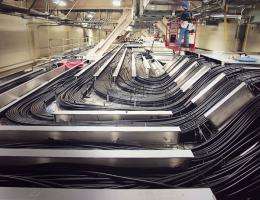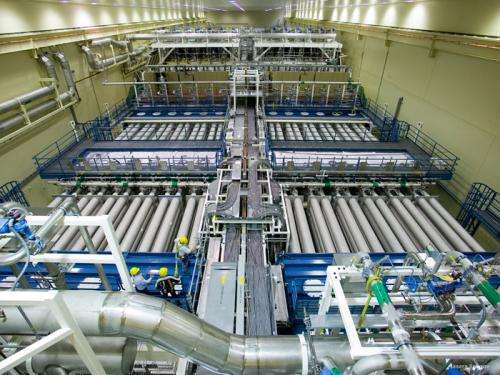September 13, 2011 weblog
Researchers at NIF moving closer to fusion ignition point

(PhysOrg.com) -- Researchers at the U.S. National Ignition Facility (NIF) report that they are growing ever closer to reaching the ignition point with their laser generated nuclear fusion project. The facility, part of the Lawrence Livermore National Laboratory has been doing research to find out if very high powered lasers could be used to create nuclear fusion that could then be used to drive steam turbines to make electricity. In related news, officials for UK companies AWE and the Rutherford Appleton Laboratory have announced that they are joining forces with the research team working on the NIF project, adding years of expertise in both nuclear fusion and laser technology.
To achieve inertial confinement fusion, researchers at the NIF project shoot multiple (192) very high powered lasers at a single pellet comprised of the hydrogen isotope deuterium, which causes it to compress to a fraction of its original size and fuse into helium atoms -releasing neutrons. The neutrons could then, in theory, be used to heat water to drive steam turbines. The only problem is, thus far, the power consumed by the lasers (some shots use more power than the whole rest of the United States) exceeds the power produced by firing them at the pellet. But, that appears to be changing.
At a meeting this past week, sponsored by London’s Royal Society, representatives from the US facility and its two new British partners met to announce the terms of agreement between them all. NIF Director Ed Moses told the group (according to the BBC) that one shot of the NIF recently produced, for just the tiniest fraction of a second, more power than all the rest of the world was consuming. And while that is certainly impressive, it’s still just a fraction of what is needed to achieve ignition; the point where a self-sustaining chain reaction occurs (required for energy gain). Moses added that he believes the group will achieve ignition within the next couple of years. Part of the reason for his optimism is the advances that have been made in high power laser diodes over the ten years since the NIF was first designed.

One possible issue the group will certainly need to discuss is the enormous number of hydrogen pellets that would be needed to feed a facility that was actually engaged in producing electricity; some estimates range to 10 pellets a second, or a million every day.
If the team is successful in its endeavor, the enormous amounts of tax dollars spent will be more than made up for in energy production. Just 1300 pounds of water, for example, could provide as much electricity as 2 million metric tons of coal.
More information: lasers.llnl.gov/
Update (9/15/2011): The story has been corrected to reflect inertial confinement fusion at NIF.
© 2011 PhysOrg.com




















